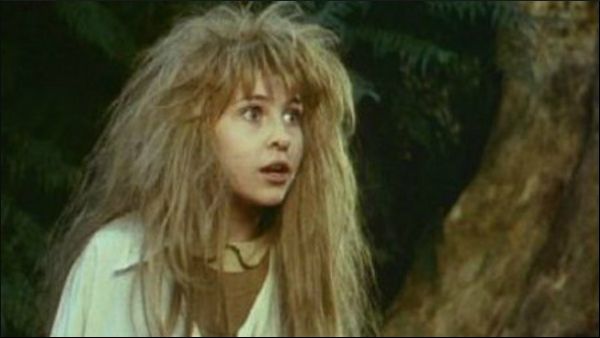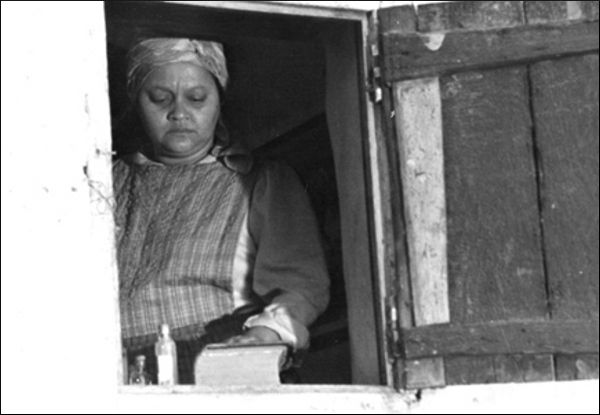Director Katinka Heyns and writer Chris Barnard got married in 1978 and together have created several of South Africa's top movies. Fiela se Kind, based on the novel of the same name by Dalene Matthee, portrays a loving family bond. It begins in 1874, in the Langkloof Valley, at Wolwekraal Farm (or "wolves’ pen," still a common name for a farm in the Garden Route, part of the south-eastern coast of South Africa). At the time, there may not have been schools in the Langkloof, but we see how an abandoned white boy is raised and educated in farming, hygiene, family life, reading, writing, and math by the black woman he has come to love as his mother, Fiela Komotie.
Fiela is the driving force behind her family. Her anchoring strength is her faith in God, the Creator of the grounds she toils on as a farmer of vegetables, aloe, and ostrich. Yet, it is clear that she does not believe in her local preachers, and therefore she does not attend church. She uses her faith to confront everyday trials, as we see ten minutes into the movie. When her son, whom she names Benjamin (pronounced Ben-ya-min) Komotie, asks her, “Mum, why are some people brown and others white?” Her answer comes naturally and without consequence: “Now you are asking God’s secrets.” He further questions her as to why he is white and she is brown, and she replies that he is a “hans kind.” The term “hans” refers to a hand-reared animal and “kind” means child. That is, he is hand-raised child.
"Director Katinka Heyns and writer Chris Barnard got married in 1978 and together have created several of South Africa's top movies. Fiela se Kind, based on the novel of the same name by Dalene Matthee, portrays a loving family bond."
We then have a short insight into a family of woodcutters, deep in Kom se Bos, a forest near the town of Knysna and still a much-frequented tourist attraction. Clearly, there is not much of a family bond here, as the father doesn’t know the age of his daughter and, when questioned by the authorities about his lost child, he needs to ask his wife when their son disappeared. When Fiela is instructed to prepare Benjamin for court, where he is to be identified by the woodcutters, she shows no fear. She reminds Benjamin that God gave him to her family. As any true mother would, Fiela breaks down in tears as her son is taken away by horse carriage. Here, as well as throughout the running time, one sees how this movie could well be a documentary about the coastlines of South Africa, since the actors’ performances are so realistic. The magistrate is portrayed as caring and truthful, though blind to many details which later surface. He does, however, get annoyed by Benjamin’s continuous use of the term “baas” or boss, which refers more to race than managerial position. He illustrates his frustration by scolding the child: “Leer jou soos 'n wit kind gedra!" (Learn to behave like a white boy!).

It is decided that Benjamin will be handed back to the woodcutters, after the mother falsely identifies him as her lost son Lukas van Rooyen. They set out for home afoot, a trip which exposes the child to a whole new reality. Before even arriving, his “new parents” eat the food his loving mother, Fiela, has packed for him. We enter the woodcutters’ abusive, soul-breaking way of life, driven by greed and anger. Lukas witnesses his sister Nina’s hair being hacked off with a butcher knife, and both siblings are forced to perform physical labor under threat of being beaten with an osseriem, the whip used on oxen while pulling the ossewa (ox-wagon).
"Somehow, despite all the hardships and broken dreams, this is not a sad and soppy movie, but one that shows the strength in faith, values, and communication."
We jump forward to 1886, when the father demands that Benjamin/Lukas go find Nina and collect three months’ money from her, once again illustrating his greed and lack of family values. Lukas travels to Knysna, where he meets South African legend John Benn. Today, John Benn is known as a luxury pleasure cruise ship, with a floating restaurant on the Knysna lagoon. But in the 1800s, John Benn was known for bravely escorting ships through the sea cliffs of the Knysna heads into the safety of the lagoon, as Knysna has no beach of its own. In the movie, Benn utters a statement of frustration, one that today has become a cliché in Afrikaans: “Ek is niemand se Oom nie,” meaning “I am nobody’s uncle.” In Afrikaans, the term “uncle” has two meanings: one is “uncle,” as we know it, and the other is proper etiquette, since it is a show of respect to address anyone older than you as “Oom,” regardless of bloodline. As this half of the movie unfolds, Lukas’ lineage becomes a serious concern to him, as he acknowledges that he has a natural understanding of the sea and, more importantly, has feelings for his sister. He then seeks Fiela’s guidance. She asks him a pertinent question, “Do you feel like a van Rooyen?,” and reveals that only one person can set him free. Lukas then speaks to his friend Kaliel, who tells him about the foreign sailors who sleep with the local women, who then raise the children on their own. Kaliel also mentions the term weggooikinders or "throw-away children," meaning children found at people’s doorsteps.
Somehow, despite all the hardships and broken dreams, this is not a sad and soppy movie, but one that shows the strength in faith, values, and communication. The script is picturesque, with many typical South African sayings and slang words, many of which are still used today. “Visvang in 'n pispot” or "fishing in a bedpan" means that “You have no chance.” “Die wind se praat” translates into “Talks of the wind,” meaning local gossip. “Betaal hul jou om die besem so krom te lê?' means “Are you getting paid to lean against the broom until it’s askew?” "Besem" is a broom, "krom" is askew, and "te lê" is to lay. Today, this idiom is often used to refer to someone caught not working on the task at hand. “Ons Komotie's is nie kaalgatte nie” translates as “We Komoties have means to get by,” which conveys dignity and defiance. "Kaal" means naked and "gatte" normally refers to "holes," though in this case it means "buttholes." The movie is named after Lukas’ revelation to Nina, as he shouts across the breaking waves to her “Fiela se kind!”, a statement that answers all prayers and doubles as the closing line of the movie.





